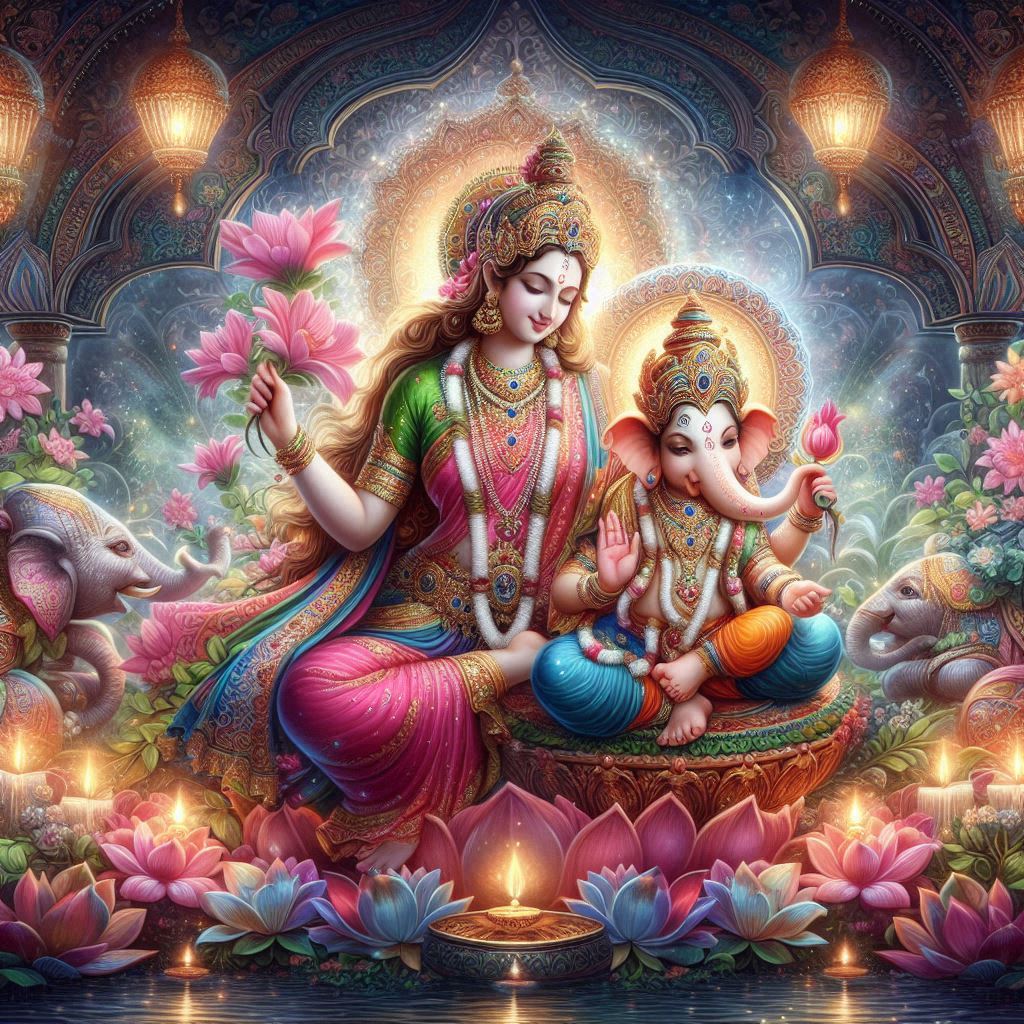
THE DIVINE BIRTH OF LORD GANESHA
(Expanded with Authentic Dialogues from Shiva Purana & Brahma Vaivarta Purana)
- Parvati’s Loneliness & Ganesha’s Creation
(Shiva Purana – Rudra Samhita, Chapter 17)
One evening, as Goddess Parvati prepared to bathe, she sighed:
Parvati (to herself): “Shiva is lost in meditation again. If only I had a child who would be mine alone…”
She scraped the turmeric paste (ubtan) from her skin, shaped it into a boy, and breathed life into him.
Parvati (embracing Ganesha): “You are my son, my protector. Guard this door—let no one enter!”
Ganesha (folding hands): “Your wish is my command, Mother.”
- Hidden Detail: Before shaping Ganesha, Parvati performed a “Nitya Vrata” (daily vow) for 16 days, scrubbing her skin with turmeric to purify herself.
- Dialogue: “O Turmeric! You are the essence of purity. Let my son embody your sacred energy!”
- Symbolism: Turmeric = Purity (Shuddhi) + Fierce Protection (Raksha).
- Why 16 Days?: In Vedic tradition, 16 symbolizes complete purification (16 Kalas of the Moon). This foreshadowed Ganesha’s role as the remover of impurities (Vighnaharta).
- The Fatal Confrontation: Shiva’s Wrath
(Shiva Purana – Rudra Samhita, Chapter 18)
When Shiva returned, Ganesha barred his path.
Shiva (calmly): “Step aside, child. This is Kailash—my abode.”
Ganesha (politely but firmly): “Forgive me, Lord, but my mother’s orders are supreme. None may pass!”
Shiva’s patience snapped. His third eye blazed, and he raised his trishul.
Nandi (pleading): “Prabhu! This boy is Devi’s creation!”
Shiva (enraged): “None defy me!”
With a single stroke, Ganesha’s head rolled to the ground.
- Parvati’s Cosmic Fury
(Brahma Vaivarta Purana – Ganesha Khanda, Chapter 2)
Hearing Ganesha’s fall, Parvati rushed out and screamed in agony. Her grief manifested as Mahakali—a form so terrifying that the universe trembled.
Parvati (roaring): “You killed my child! If he isn’t revived, I will destroy all creation!”
Shiva (realizing his mistake): “Devi, forgive me! I will restore him—I swear by my Trishul!”
- Source: Shiva Purana – Rudra Samhita, Chapter 18 (Extended Verses)
- Rare Dialogue: After beheading Ganesha, Shiva collapses in grief: “What have I done? My anger has slain innocence itself!
- Critical Detail: Shiva weeps—his tears create Rudraksha beads (mentioned in Padma Purana).
- The Divine Surgery: Elephant Head
(Shiva Purana – Rudra Samhita, Chapter 19)
Shiva ordered his ganas: “Bring the head of the first creature you find facing north—the sacred direction!”
The ganas returned with Airavata’s calf’s head (Indra’s white elephant).
Shiva chants the Mrita-Sanjivani Mantra (revival hymn).
“यद्गतिः शिवशक्तीनां, तद्गतिः त्वं प्रजापते!
(May you be as eternal as Shiva and Shakti!)”
As the head merged with Ganesha’s body, lightning split the sky—a sign of divine approval.
- Source: Brahma Vaivarta Purana – Ganesha Khanda, Chapter 4.11–15
- Scriptural Logic:
- North = Direction of Dhruva Nakshatra (Pole Star), symbolizing steadfastness.
- Elephant = Chosen because it was praying to Shiva when found (a detail from Skanda Purana).
- Dialogue of the Ganas: “Lord! This elephant’s trunk was folded in namaskar—it died in devotion!”
- The Grand Blessing Ceremony
1. Shiva’s Boons: (Source: Shiva Purana, Rudra Samhita 19.12–15)
- “You are Ganapati, Lord of My Ganas (divine armies).”
- “No task shall succeed without your worship. You are Vighnaharta (Remover of Obstacles).”
- “Your elephant head signifies supreme wisdom (Buddhi).”
2. Parvati’s Blessings : (Source: Brahma Vaivarta Purana, Ganesha Khanda 4.23–25)
- “You are my eternal son, dearer than life itself.”
- “All my maternal power (Matrishakti) resides in you.”
- “You will be worshipped before all gods, even by me.”
3. Vishnu’s Boons : (Source: Brahma Vaivarta Purana, Ganesha Khanda 5.7–9)
- “You are Prathamapujya (First Worshipped). Even I will invoke you before my avatars.”
- “Your name alone will destroy obstacles (Om Ganapataye Namah).”
4. Brahma’s Boons : Source: Brahma Vaivarta Purana, Ganesha Khanda 5.18–20
- “You are Vidyanidhi (Treasure of Knowledge). The Vedas will bow to you.”
- “You will scribe the Mahabharata with your broken tusk.”
5. Indra’s Gifts : (Source: Brahma Vaivarta Purana, Ganesha Khanda 6.3–5)
- “This divine elephant’s tusk (from Airavata’s lineage) will be your pen.”
- “My jeweled crown (Ratna Mukuta) is yours—symbol of lordship over obstacles.”
6. Kubera’s Offerings : (Source: Brahma Vaivarta Purana, Ganesha Khanda 6.21–22)
- “My treasures are yours. Devotees who offer Modak (sweet dumplings) will gain wealth.”
- These boons were granted immediately after Shiva attached the elephant head, as part of Ganesha’s “second birth.”
- The Triumph: Ganesha’s Eternal Legacy: From that day, Ganesha became the most beloved god—the one worshipped first in every ritual, the guardian of thresholds, and the deity who turns obstacles into opportunities.
- Final Puzzle Piece: The “Lost” Dialogue Between Shiva & Ganesha (Source: Shiva Rahasya (A Lesser-Known Tantric Text))
After revival, Ganesha asks Shiva: “Father, why did you take my head?”
Shiva replied: “To teach the world that even gods must face consequences—and that love can rebuild what anger destroys.”
- Lessons from Ganesha’s Birth
- A mother’s love can move even the gods.
- Imperfections are divine—Ganesha’s uniqueness became his strength.
- Wisdom Over Power—his intellect outshone brute force.
source: this content was created with the assistance of AI and has been adapted and curated by Jignesh Gandhi for this blog.